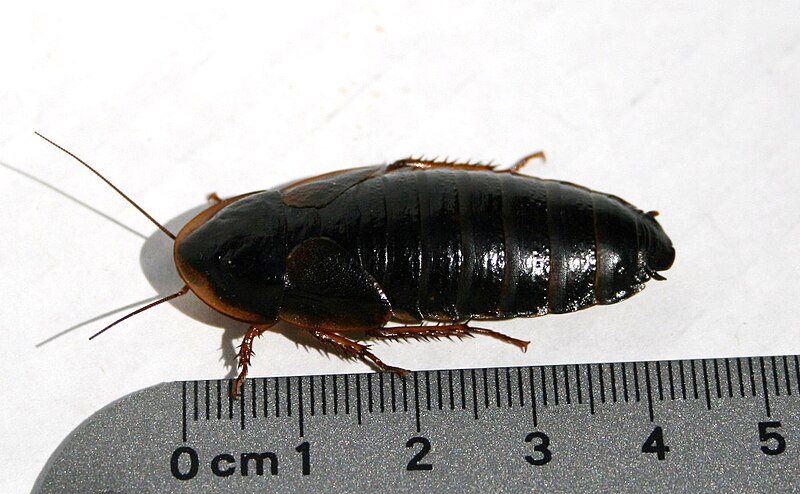 Hello, Frank Indiviglio here.
Hello, Frank Indiviglio here.
The orange-spotted or guyana roach, Blaptica dubia, often starts out as pet food but winds up as a pet. It’s small wonder, as these attractive insects are very interesting in their own right, and most agreeable to exhibiting their natural behaviors to the patient observer.
Coming into Their Own
Roaches are finally getting the attention they deserve from pet keepers, and even zoos are beginning to highlight them in exhibits. I housed many species at the Staten Island Zoo, and a new exhibit at the Bronx Zoo features a hollow tree stocked with thousands of Malagasy hissing roaches. But my favorite was set up many years ago at the Cincinnati Zoo’s groundbreaking Insectarium….visitors looked through a cutaway cabinet at a “kitchen” stocked with a colony American roaches. The huge insects were fed from cereal boxes, sandwiches left on a table and so forth…years later I tried to replicate this at the Bronx Zoo, for Norway rats, but the idea failed to impress my curator!
Classification and Diversity
Cockroaches, with a fossil record stretching back 300 million years, are classified within the order Blattaria (or Blattodea). Over 4,000 species have been described, and entomologists believe that as many more may be awaiting discovery. The largest species, Latin America’s Megaloblatta baberoides, sports a 7 inch wingspan while the heaviest, Macropameothia rhinoceros of Australia, weighs in at 1 ½ ounces. The lime green banana roach, Panchlora nivea, sometimes available in the pet trade, is to my eye the most attractive.
Orange-Spotted Roaches
The orange-spotted roach ranges from tan to reddish-brown and black in color, and is mottled with light orange dots. It reaches 1 ¾ inches in length. The natural range is usually given as northern South America, but there are records from as far north as Panama and as far south as northern Argentina.
As a Feeder Insect
This roach makes an excellent feeder insect as it rarely flies and cannot scale glass or plastic (unless either is very dirty!). Adults and juveniles alike have a soft exoskeleton, and are thus an ideal food for amphibians, birds, spiders, scorpions, fishes, reptiles and certain small mammals (I have used them as treats for flying squirrels and deer mice). The nymphs are only .1 inches in length, and eagerly accepted by tiny amphibians and reptiles.
CAPTIVE HUSBANDRY
Note: long term exposure to insect colonies may lead to sensitivities or allergies in some people. You may wish to consult your doctor in this regard.
Captive Habitat
The Enclosure
Orange spotted roaches can be housed in plastic terrariums, aquariums or sweater boxes. Sweater boxes should be ventilated with screened-over panels cut into the lids and sides. Fine-meshed “insect screening” is best, as the nymphs are quite small. Be sure that the mesh size on commercial terrarium lids is small as well – if unsure, add a second layer of finer mesh. The roaches can chew through some plastic screening, so use metal when re-screening.
Heat and Humidity
This species tolerates temperatures from 68-95 F, with breeding and growth being most rapid at higher temperatures. If you are interested in observing them, and not in producing large numbers as a food source, 75 F is ideal.
Heat may be provided by an incandescent bulb during the day and a reptile night light during the evening. I highly recommend the latter…the roaches will feed by day, but really put on a show at night, and a night light will allow you to observe them doing so. A ceramic heater or under-tank heater may also be used. In all cases watch that you do not over-dry the terrarium (keep an eye on shedding, please see below).
Orange-spotted roaches tolerate far drier conditions than do most of their relatives. Technically, they can run into difficulty in molting if a bit of humidity is not provided, but this is not common.
Misting the enclosure can result in the growth of mold and fungi, some species of which may be linked to colony failure. If conditions warrant it, mist lightly (glass only, not cardboard if such is used as a substrate) and be sure the glass dries within an hour or so.
Click: The Orange Spotted Roach: an Interesting Pet and Valuable Food for Reptiles, Amphibians, Invertebrates, Birds and Fishes – Part 2, to read the second part of this article.
Image referenced from Wikipedia Commons, here.

 As has always been my practice, I add a bit of Tetra-Min Flake Fish Food to the commercial cricket foods. Both are consumed ravenously, and the wide variety of ingredients in the flakes helps assure that the crickets are receiving a healthful diet.
As has always been my practice, I add a bit of Tetra-Min Flake Fish Food to the commercial cricket foods. Both are consumed ravenously, and the wide variety of ingredients in the flakes helps assure that the crickets are receiving a healthful diet. That Reptile Blog – Reptile, Amphibian and Exotic Pet Care and Information
That Reptile Blog – Reptile, Amphibian and Exotic Pet Care and Information

 Click:
Click: 
